Lyumjev
Generic name: insulin lispro
Drug class: Insulin
Medically reviewed by A Ras MD.
What is Lyumjev?
Lyumjev is man-made fast-acting insulin used to control high blood sugar in adults with diabetes mellitus. It is not known if Lyumjev is safe and effective in children.
Description
Insulin lispro-aabc is a rapid-acting human insulin analog used to lower blood glucose. Insulin lispro-aabc is produced by recombinant DNA technology utilizing a non-pathogenic laboratory strain of Escherichia coli. Insulin lispro-aabc differs from human insulin in that the amino acid proline at position B28 is replaced by lysine and the lysine in position B29 is replaced by proline. Chemically, it is Lys(B28), Pro(B29) human insulin analog and has the empirical formula C257H383N65O77S6 and a molecular weight of 5808 daltons, both identical to that of human insulin.
Insulin lispro-aabc has the following primary structure:
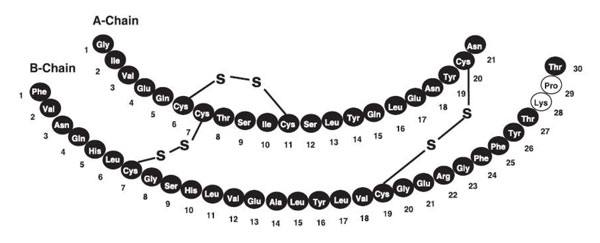
LYUMJEV (insulin lispro-aabc) injection is a sterile, aqueous, clear, and colorless solution for subcutaneous or intravenous administration. Each mL of LYUMJEV U-100 contains 100 units of insulin lispro-aabc and the inactive ingredients: glycerol (12.1 mg), magnesium chloride hexahydrate (1.02 mg), metacresol (3.15 mg), sodium citrate dihydrate (4.41 mg), treprostinil sodium (1.06 mcg), zinc oxide (content adjusted to provide 39 mcg zinc ion), and Water for Injection, USP.
Each mL of LYUMJEV U-200 contains 200 units of insulin lispro-aabc and the inactive ingredients: glycerol (12.1 mg), magnesium chloride hexahydrate (1.02 mg), metacresol (3.15 mg), sodium citrate dihydrate (4.41 mg), treprostinil sodium (1.06 mcg), zinc oxide (content adjusted to provide 52 mcg zinc ion), and Water for Injection, USP.
Hydrochloric acid and/or sodium hydroxide may be added to adjust the pH. LYUMJEV has a pH of 7.0 to 7.8.
Mechanism of Action
The primary activity of LYUMJEV is the regulation of glucose metabolism. Insulins, including insulin lispro-aabc, exert their specific action through binding to insulin receptors. Receptor-bound insulin lowers glucose by stimulating peripheral glucose uptake by skeletal muscle and fat, and by inhibiting hepatic glucose production. Insulins inhibit lipolysis and proteolysis, and enhance protein synthesis.
What is the most important information I should know about Lyumjev?
Do not share your Lyumjev with other people, even if the needle has been changed. You may give other people a serious infection, or get a serious infection from them.
Who should not take Lyumjev?
Do not take Lyumjev if you:
- are having an episode of low blood sugar (hypoglycemia).
- have an allergy to insulin lispro-aabc or any of the ingredients in Lyumjev. See the end of this Patient Information guide for a complete list of ingredients in Lyumjev.
What should I tell my healthcare provider before taking Lyumjev?
Before taking Lyumjev, tell your healthcare provider about all of your medical conditions, including if you:
- have kidney or liver problems.
- take any other medicines, especially ones called thiazolidinediones (TZDs).
- have heart failure or other heart problems. If you have heart failure, it may get worse while you take TZDs with Lyumjev.
- are pregnant or plan to become pregnant. Talk with your healthcare provider about the best way to control your blood sugar if you plan to become pregnant or while you are pregnant.
- are breastfeeding or plan to breastfeed. It is not known if Lyumjev passes into your breast milk. You and your healthcare provider should decide if you will take Lyumjev while you breastfeed.
Tell your healthcare provider about all the medicines you take, including prescription and over-the-counter medicines, vitamins, and herbal supplements.
Before you start taking Lyumjev, talk to your healthcare provider about low blood sugar and how to manage it.
How should I take Lyumjev?
- Read the Instructions for Use that come with your Lyumjev.
- Take Lyumjev exactly as your healthcare provider tells you to. Your healthcare provider will tell you how much Lyumjev to take and when to take it.
- Lyumjev starts acting fast. Inject Lyumjev at the beginning of a meal or within 20 minutes after you start eating a meal.
- Know the type and strength of insulin you take. Do not change the type or amount of insulin you take unless your healthcare provider tells you to. The amount of insulin and the best time for you to take your insulin may need to change if you take different types of insulin.
- Check your insulin label each time you give your injection to make sure you are using the correct insulin.
- Check your blood sugar levels. Ask your healthcare provider what your blood sugars should be and when you should check your blood sugar level.
- Lyumjev comes in U-100 (100 units/mL) and U-200 (200 units/mL) insulin strengths. Lyumjev U-200 contains 2 times as much insulin (200 units/mL) in 1 mL as Lyumjev U-100 (100 units/mL).
- Lyumjev U-100 and Lyumjev U-200 can be injected under the skin (subcutaneously) of your stomach area, buttocks, upper legs, or upper arms.
- Lyumjev U-100 can be given by continuous infusion under the skin (subcutaneously) through an insulin pump into an area of your body recommended in the instructions that come with your insulin pump. Lyumjev U-200 cannot be given through an insulin pump.
- Lyumjev U-100 can also be given in your vein (intravenously) by your healthcare provider. Lyumjev U-200 cannot be given in your vein.
- Change (rotate) your injection sites within the area you choose with each dose to reduce your risk of getting pits in skin or thickened skin (lipodystrophy) and skin with lumps (localized cutaneous amyloidosis) at the injection sites.
- Do not use the exact same spot for each injection.
- Do not inject where the skin has pits, is thickened, or has lumps.
- Do not inject where the skin is tender, bruised, scaly or hard, or into scars or damaged skin.
- If you miss a dose of Lyumjev, monitor your blood sugar levels to decide if an insulin dose is needed. Continue with your regular dosing schedule at the next meal.
- Lyumjev comes in a vial, single-patient-use prefilled pen, or in a cartridge. Do not use a syringe to remove Lyumjev from your single-patient-use prefilled pen or cartridge.
Keep Lyumjev and all medicines out of the reach of children
Your dose of Lyumjev may need to change because of a change in level of physical activity or exercise, weight gain or loss, increased stress, illness, change in diet, or because of other medicines you take.
What should I avoid while taking Lyumjev?
While taking Lyumjev do not:
- drive or operate heavy machinery, until you know how Lyumjev affects you.
- drink alcohol or take other medicines that contain alcohol.
What are the possible side effects of Lyumjev?
Lyumjev may cause serious side effects that can lead to death, including:
- low blood sugar (hypoglycemia). Signs and symptoms that may indicate low blood sugar include: dizziness or light-headedness, sweating, confusion, headache, blurred vision, slurred speech, shakiness, fast heartbeat, hunger, anxiety, irritability, or mood changes.
- low potassium in your blood (hypokalemia).
- serious allergic reactions (whole body allergic reaction). Get emergency medical help right away, if you have any of these symptoms of a severe allergic reaction: a rash over your whole body, trouble breathing, a fast heartbeat, swelling of your face, tongue, or throat, sweating, or feeling faint.
- heart failure. Taking certain diabetes pills called thiazolidinediones (TZDs) with Lyumjev may cause heart failure in some people. This can happen even if you have never had heart failure or heart failure problems before. If you already have heart failure it may get worse while you take TZDs with Lyumjev. Your healthcare provider should monitor you closely while you are taking TZDs with Lyumjev. Tell your healthcare provider if you have any new or worse symptoms of heart failure including: shortness of breath, swelling of your ankles or feet, or sudden weight gain. Treatment with TZDs and Lyumjev may need to be adjusted or stopped by your healthcare provider if you have new or worse heart failure.
- sudden onset of high blood sugar (hyperglycemia) and high amounts of ketones in the blood or urine (ketoacidosis) due to insulin pump problems. If LYUMEV is given through an insulin pump and the pump is not working the right way or in case of handling errors, you may not get the right amount of insulin, which can cause a sudden onset of high blood sugar and high amounts of ketones in the blood or urine.
Get emergency medical help if you have:
- trouble breathing, shortness of breath, fast heartbeat, swelling of your face, tongue or throat, sweating, extreme drowsiness, dizziness, or confusion.
The most common side effects of Lyumjev include:
- low blood sugar (hypoglycemia)
- allergic reactions
- rash
- itching (pruritus)
- thickening or pits at the injection or infusion site (lipodystrophy)
- weight gain
- reactions or pain at the site of injection or at the site of infusion with insulin pump use (treprostinil sodium and sodium citrate dihydrate are inactive ingredients in Lyumjev that have been known to cause reactions and pain at the infusion and injection sites in other non-insulin medicines)
These are not all the possible side effects of Lyumjev. Call your doctor for medical advice about side effects. You may report side effects to FDA at 1-800-FDA-1088.
General information about the safe and effective use of Lyumjev
Medicines are sometimes prescribed for purposes other than those listed in a Patient Information leaflet. Do not take Lyumjev for a condition for which it was not prescribed. Do not give Lyumjev to other people, even if they have the same symptoms that you have. It may harm them.
You can ask your pharmacist or healthcare provider for information about Lyumjev that is written for health professionals.
How should I store Lyumjev?
Vials
All not in-use (unopened) vials:
- Store all not in-use (unopened) vials in the refrigerator at 36°F to 46°F (2°C to 8°C).
- Do not freeze. Do not use if Lyumjev has been frozen.
- Keep away from direct heat and light.
- Not in-use (unopened) vials can be used until the expiration date on the carton and label, if they have been stored in the refrigerator.
- Not in-use (unopened) vials should be thrown away after 28 days, if they are stored at room temperature.
After vials have been in-use (opened):
- Store in-use (opened) vials in the refrigerator or at room temperature below 86°F (30°C) for up to 28 days.
- Keep vials away from direct heat and light.
- Throw away all in-use (opened) vials after 28 days of use, even if there is insulin left in the vial.
Keep Lyumjev vials, syringes, needles and all medicines out of the sight and reach of children.
KwikPen, Junior KwikPen or Tempo Pen
Unused Pens
- Store unused Pens in the refrigerator at 36°F to 46°F (2°C to 8°C).
- Do not freeze Lyumjev. Do not use if it has been frozen.
- Unused Pens may be used until the expiration date printed on the label if the Pen has been kept in the refrigerator.
In-use Pen
- Store the Pen you are currently using at room temperature [up to 86°F (30°C)]. Keep away from heat and light.
- Throw away the Lyumjev KwikPen, Junior KwikPen or Tempo Pen you are using after 28 days, even if it still has insulin left in it.
What are the ingredients in Lyumjev?
Active ingredient: insulin lispro-aabc
Inactive ingredients: glycerol, magnesium chloride hexahydrate, metacresol, sodium citrate dihydrate, treprostinil sodium, zinc oxide (zinc ion), and Water for Injection, USP
For more information, go to www.lilly.com or call 1-800-545-5979.
Instructions for use for Lyumjev
- Lyumjev injection
- Lyumjev KwikPen 100 units/ mL
- Lyumjev Junior KwikPen
- Lyumjev Tempo Pen
- Lyumjev KwikPen 200 units/mL
Lyumjev (LOOM-jehv) Vials
(insulin lispro-aabc) injection
for subcutaneous use
(100 units/mL, 10 mL multiple-dose vial)
Read the Instructions for Use before you start taking Lyumjev and each time you get a new vial. There may be new information. This information does not take the place of talking to your healthcare provider about your medical condition or your treatment.
Do not share your syringes or needles with other people. You may give other people a serious infection or get a serious infection from them.
Supplies needed to give your injection
- a multiple-dose Lyumjev vial
- a U-100 insulin syringe and needle (Becton, Dickinson and Company syringes and needles recommended)
- 2 alcohol swabs
- gauze (optional)
- 1 sharps container for throwing away used syringes and needles. See “Disposing of used syringes and needles” at the end of these instructions.
Vial
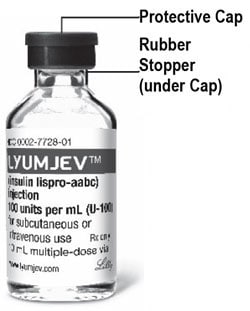
Syringe
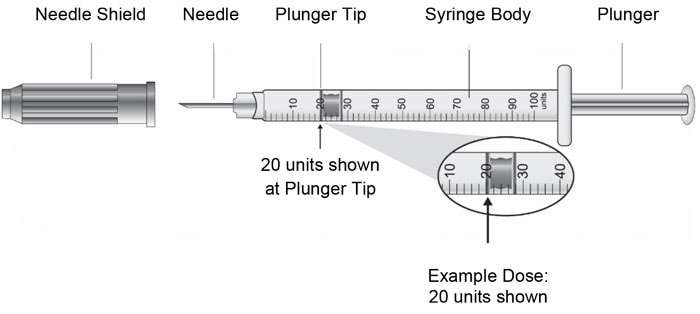
Preparing your Lyumjev dose
- Wash your hands with soap and water.
- Check the Lyumjev label to make sure you are taking the right type of insulin. This is especially important if you use more than 1 type of insulin.
- Lyumjev should look clear and colorless. Do not use Lyumjev if it is thick, cloudy, or colored, or if you see lumps or particles in it.
- Do not use Lyumjev past the expiration date printed on the label or 28 days after you first use it.
- Always use a new syringe and needle for each injection to prevent infections and blocked needles.
- Do not mix Lyumjev U-100 with other insulins.
Step 1:
If you are using a new vial, pull off the plastic protective cap, but do not remove the rubber stopper.
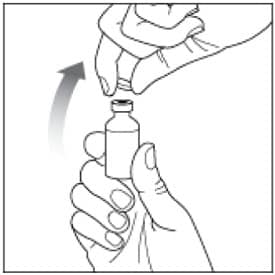
Step 2:
Wipe the rubber stopper with an alcohol swab.
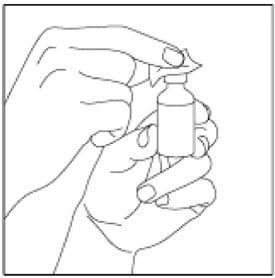
Step 3:
Remove the needle shield from the syringe by pulling the needle shield straight off. Hold the syringe with the needle pointing up. Pull down on the plunger until the plunger tip reaches the line for the number of units for your prescribed dose.
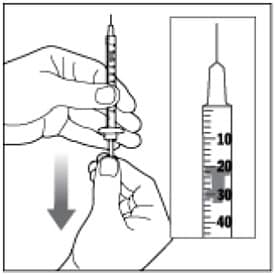
(Example Dose: 10 units shown)
Step 4:
Push the needle through the rubber stopper of the vial.
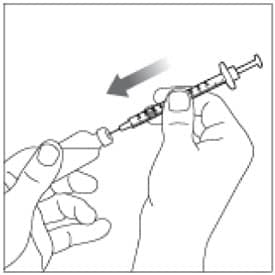
Step 5:
Push the plunger all the way in. This puts air into the vial.
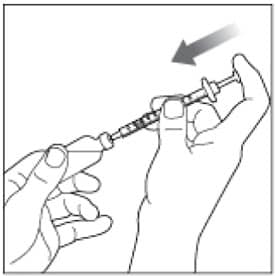 s
s
Step 6:
Turn the vial and syringe upside down and slowly pull the plunger down until the plunger tip is a few units past the line for your prescribed dose.
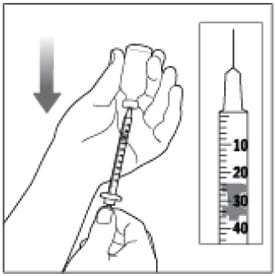
(Example Dose: 20 units, plunger is shown at 24 units)
If there are air bubbles, tap the syringe gently a few times to let any air bubbles rise to the top.
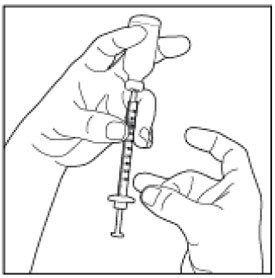
Step 7:
Slowly push the plunger up until the plunger tip reaches the line for your prescribed dose.
Check the syringe to make sure that you have the right dose.
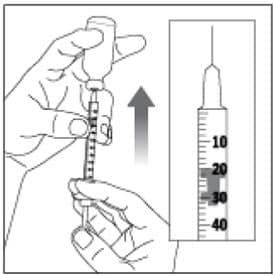
(Example Dose: 20 units shown)
Step 8:
Pull the syringe out of the rubber stopper of the vial.
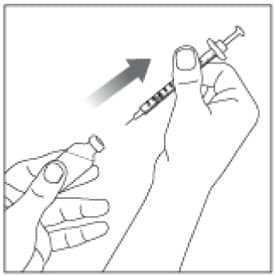
Giving your Lyumjev injection with a syringe
- Inject your insulin exactly as your healthcare provider has shown you. Your healthcare provider should tell you if you should pinch the skin before injecting.
- Lyumjev starts acting fast, so give your injection at the start of a meal or within 20 minutes after you start a meal.
- Change (rotate) your injection sites within the area you choose for each dose to reduce your risk of getting lipodystrophy (pits in skin or thickened skin) and localized cutaneous amyloidosis (skin with lumps) at the injection sites.
- Do not use the exact same spot for each injection.
- Do not inject where the skin has pits, is thickened, or has lumps.
- Do not inject where the skin is tender, bruised, scaly or hard, or into scars or damaged skin.
Step 9:
Choose your injection site.
Lyumjev is injected under the skin (subcutaneously) of your stomach area (abdomen), buttocks, upper legs, or upper arms.
Wipe your skin with an alcohol swab, and let your skin dry before you inject your dose.
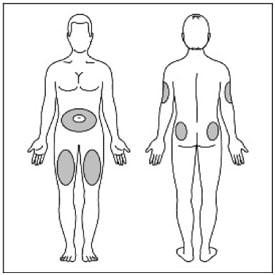
Step 10:
Insert the needle into your skin.
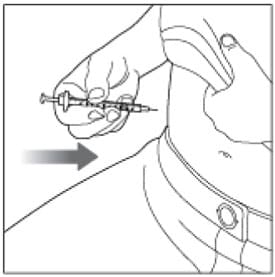
Step 11:
Push down on the plunger to inject your dose.
The needle should stay in your skin for at least 5 seconds after pushing down on the plunger to make sure you have injected all of your insulin dose.
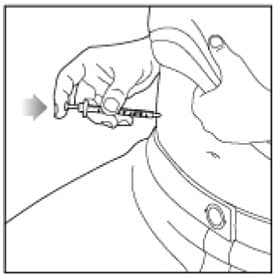
Step 12:
Pull the needle out of your skin.
- If you see blood after you take the needle out of your skin, press the injection site with a piece of gauze or an alcohol swab. Do not rub the area.
- Do not recap the needle. Recapping the needle can lead to a needle stick injury.
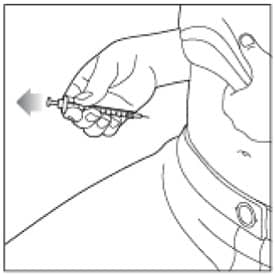
Giving your Lyumjev using an insulin pump
- If you have been prescribed an insulin pump, check the pump manufacturer’s user manual to see if Lyumjev can be used with the pump.
- Lyumjev should be given into an area of your body recommended in the instructions that come with your insulin pump.
- Change Lyumjev in the pump reservoir at least every 9 days or according to the pump user manual, whichever is shorter, even if you have not used all of the insulin.
- Change (rotate) your insertion sites within the area you choose for each insertion to reduce your risk of getting lipodystrophy (pits in skin or thickened skin) and localized cutaneous amyloidosis (skin with lumps) at the insertion sites. Do not insert into the exact same spot for each insertion. Do not insert where the skin has pits, is thickened, or has lumps. Do not insert where the skin is tender, bruised, scaly or hard, or into scars or damaged skin.
- Call your healthcare provider and choose a new infusion site if the skin at the infusion site becomes red, itchy, or thickened.
- Your healthcare provider should provide recommendations for appropriate pump basal and meal-time infusion rates. Call your healthcare provider if you have any questions about using the insulin pump.
- Do not dilute or mix Lyumjev with any other type of insulin in your insulin pump.
- You should be trained on how to give insulin by injection and have an alternative insulin delivery system in case of pump failure.
Disposing of used syringes and needles
- Put your used syringes and needles in a FDA-cleared sharps disposal container right away after use. Do not throw away (dispose of) loose syringes and needles in your household trash.
- If you do not have a FDA-cleared sharps disposal container, you may use a household container that is:
- made of a heavy-duty plastic,
- can be closed with a tight-fitting, puncture-resistant lid, without sharps being able to come out,
- upright and stable during use,
- leak-resistant, and
- properly labeled to warn of hazardous waste inside the container.
- When your sharps disposal container is almost full, you will need to follow your community guidelines for the right way to dispose of your sharps disposal container. There may be state or local laws about how you should throw away used syringes and needles. For more information about safe sharps disposal, and for specific information about sharps disposal in the state that you live in, go to the FDA’s website at: http://www.fda.gov/safesharpsdisposal.
- Do not dispose of your used sharps disposal container in your household trash unless your community guidelines permit this. Do not recycle your used sharps disposal container.
How should I store Lyumjev?
All not in-use (unopened) vials:
- Store all not in-use (unopened) vials in the refrigerator at 36°F to 46°F (2°C to 8°C).
- Do not freeze. Do not use if Lyumjev has been frozen.
- Keep away from direct heat and light.
- Not in-use (unopened) vials can be used until the expiration date on the carton and label, if they have been stored in the refrigerator.
- Not in-use (unopened) vials should be thrown away after 28 days, if they are stored at room temperature.
After vials have been in-use (opened):
- Store in-use (opened) vials in the refrigerator or at room temperature below 86°F (30°C) for up to 28 days.
- Keep vials away from direct heat and light.
- Throw away all in-use (opened) vials after 28 days of use, even if there is insulin left in the vial.
Lyumjev in an insulin pump:
- Throw away Lyumjev in the pump reservoir if it has been exposed to temperatures higher than 98.6°F (37°C).
Keep Lyumjev vials, syringes, needles and all medicines out of the sight and reach of children.
If you have any questions or problems with your Lyumjev, contact Lilly at 1-800-Lilly-Rx (1-800-545-5979) or call your healthcare provider for help. For more information on Lyumjev and insulin, go to www.Lyumjev.com.
Instructions for use revised 08/2021.
Lyumjev KwikPen (LOOM-jehv) 100 units/ mL
(insulin lispro-aabc)
injection, for subcutaneous use
3 mL single-patient-use pen
100 units/mL

Read the Instructions for Use before you start taking Lyumjev and each time you get another Lyumjev KwikPen. There may be new information. This information does not take the place of talking to your healthcare provider about your medical condition or your treatment.
Do not share your Lyumjev KwikPen with other people, even if the needle has been changed. Do not reuse or share needles with other people. You may give other people a serious infection or get a serious infection from them.
Lyumjev KwikPen (“Pen”) is a disposable single-patient-use prefilled pen containing 300 units of Lyumjev.
- Your healthcare provider will tell you how many units to give as your dose and how to inject your prescribed dose of insulin.
- You can give yourself more than 1 dose from the Pen.
- Each turn of the dose knob dials 1 unit of insulin. You can give from 1 to 60 units in a single injection.
- If your dose is more than 60 units, you will need to give yourself more than 1 injection. Always check the number in the dose window to make sure you dialed the correct dose.
- The plunger only moves a little with each injection, and you may not notice that it moves. The plunger will only reach the end of the cartridge when you have used all 300 units in the Pen.
People who are blind or have vision problems should not use the Pen without help from a person trained to use the Pen.


How to recognize your Lyumjev KwikPen
- Pen color: Taupe
- Dose Knob: Blue, with raised ridges on side
- Label: Blue and white
Supplies needed to give your injection
- Lyumjev KwikPen, 100 units/mL
- KwikPen compatible needle (Becton, Dickinson and Company Pen needles recommended)
- Alcohol swab
- Gauze (optional)
Preparing your Pen
- Wash your hands with soap and water.
- Check the Pen to make sure you are taking the right type of insulin. This is especially important if you use more than 1 type of insulin.
- Do not use your Pen past the expiration date printed on the label or for more than 28 days after you first start using the Pen.
- Always use a new needle for each injection to help prevent infections and blocked needles.
Step 1:
- Pull the Pen cap straight off.
- Do not remove the Pen label.
- Wipe the rubber seal with an alcohol swab.

Step 2:
- Check the liquid in the Pen.
- Lyumjev should look clear and colorless. Do not use if it is cloudy, colored, or has particles or clumps in it.
Step 3:
- Select a new needle.
- Pull off the paper tab from the outer needle shield.
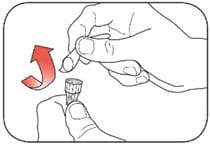
Step 4:
- Push the capped needle straight onto the Pen and twist the needle on until it is tight.
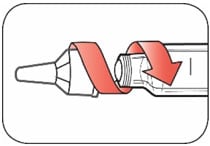
Step 5:
- Pull off the outer needle shield. Do not throw it away.
- Pull off the inner needle shield and throw it away.
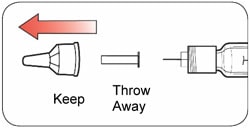
Priming your Pen
Prime before each injection.
- Priming your Pen means removing the air from the needle and cartridge that may collect during normal use and ensures that your Pen is working correctly.
- If you do not prime before each injection, you may get too much or too little insulin.
Step 6:
- To prime your Pen, turn the dose knob to select 2 units.
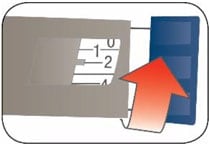
Step 7:
- Hold your Pen with the needle pointing up. Tap the cartridge holder gently to collect air bubbles at the top.
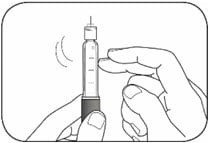
Step 8:
- Continue holding your Pen with the needle pointing up. Push the dose knob in until it stops and “0” is seen in the dose window. Hold the dose knob in and count to 5 slowly.
You should see insulin at the tip of the needle.
- If you do not see insulin, repeat priming steps 6 to 8, but not more than 4 times.
- If you still do not see insulin, change the needle and repeat priming steps 6 to 8.
Small air bubbles are normal and will not affect your dose.
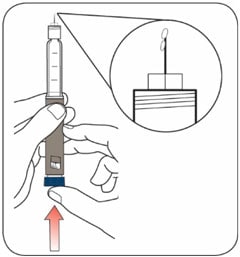
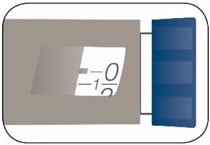
Selecting your dose
- You can give from 1 to 60 units in a single injection.
- If your dose is more than 60 units, you will need to give more than 1 injection.
- If you need help with dividing up your dose the right way, ask your healthcare provider.
- Use a new needle for each injection and repeat the priming steps.
Step 9:
- Turn the dose knob to select the number of units you need to inject. The dose indicator should line up with your dose.
- The Pen dials 1 unit at a time.
- The dose knob clicks as you turn it.
- Do not dial your dose by counting the clicks. You may dial the wrong dose. This may lead to you getting too much insulin or not enough insulin.
- The dose can be corrected by turning the dose knob in either direction until the correct dose lines up with the dose indicator.
- The even numbers are printed on the dial. The example to the right shows 12 units in the dose window.
- The odd numbers, after the number 1, are shown as full lines between the numbers. The example to the right shows 25 units in the dose window.
- Always check the number in the dose window to make sure you have dialed the correct dose.
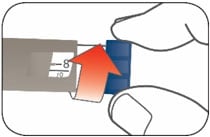
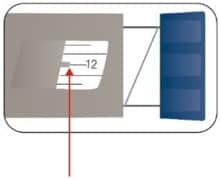
Example: 12 units shown in the dose window
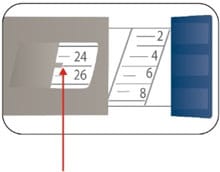
Example: 25 units shown in the dose window
- The Pen will not let you dial more than the number of units left in the Pen.
- If you need to inject more than the number of units left in the Pen, you may either:
- inject the amount left in your Pen and then use a new Pen to give the rest of your dose, or
- get a new Pen and inject the full dose.
- It is normal to see a small amount of insulin left in the Pen that you cannot inject.
Giving your injection
- Inject your insulin as your healthcare provider has shown you.
- Change (rotate) your injection sites within the area you choose for each dose to reduce your risk of getting lipodystrophy (pits in skin or thickened skin) and localized cutaneous amyloidosis (skin with lumps) at the injection sites.
- Do not use the exact same spot for each injection.
- Do not inject where the skin has pits, is thickened, or has lumps.
- Do not inject where the skin is tender, bruised, scaly or hard, or into scars or damaged skin.
- Do not try to change your dose while injecting.
Step 10:
- Choose your injection site.
Lyumjev is injected under the skin (subcutaneously) of your stomach area, buttocks, upper legs or upper arms. - Wipe your skin with an alcohol swab, and let your skin dry before you inject your dose.
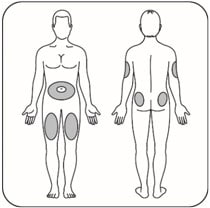
Step 11:
- Insert the needle into your skin.
- Push the dose knob all the way in.
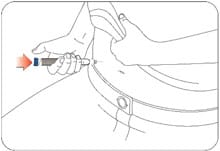
- Continue to hold the dose knob in and slowly count to 5 before removing the needle.
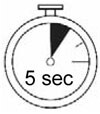
Do not try to inject your insulin by turning the dose knob. You will not receive your insulin by turning the dose knob.
Step 12:
- Pull the needle out of your skin.
- A drop of insulin at the needle tip is normal. It will not affect your dose.
- Check the number in the dose window.
- If you see “0” in the dose window, you have received the full amount you dialed.
- If you do not see “0” in the dose window, you did not receive your full dose. Do not redial. Insert the needle into your skin and finish your injection.
- If you still do not think you received the full amount you dialed for your injection, do not start over or repeat that injection. Monitor your blood glucose as instructed by your healthcare provider.
- If you normally need to give 2 injections for your full dose, be sure to give your second injection.
The plunger only moves a little with each injection, and you may not notice that it moves.
If you see blood after you take the needle out of your skin, press the injection site lightly with a piece of gauze or an alcohol swab. Do not rub the area.
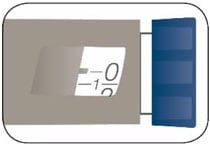
After your injection
Step 13:
- Carefully replace the outer needle shield.
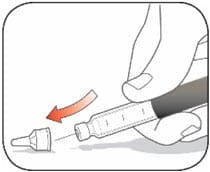
Step 14:
- Unscrew the capped needle and throw it away (see Disposing of pens and needles section).
- Do not store the Pen with the needle attached to prevent leaking, blocking the needle, and air from entering the Pen.
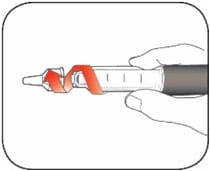
Step 15:
- Replace the Pen cap by lining up the cap clip with the dose indicator and pushing straight on.
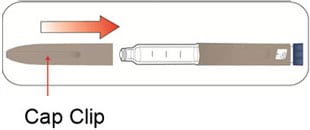
Disposing of Pens and needles
- Put your used needles in a FDA-cleared sharps disposal container right away after use. Do not throw away (dispose of) loose needles in your household trash.
- If you do not have a FDA-cleared sharps disposal container, you may use a household container that is:
- made of a heavy-duty plastic,
- can be closed with a tight-fitting, puncture-resistant lid, without sharps being able to come out,
- upright and stable during use,
- leak-resistant, and
- properly labeled to warn of hazardous waste inside the container.
- When your sharps disposal container is almost full, you will need to follow your community guidelines for the right way to dispose of your sharps disposal container. There may be state or local laws about how you should throw away used needles and syringes. For more information about safe sharps disposal, and for specific information about sharps disposal in the state that you live in, go to the FDA’s website at: http://www.fda.gov/safesharpsdisposal
- Do not dispose of your used sharps disposal container in your household trash unless your community guidelines permit this. Do not recycle your used sharps disposal container.
- The used Pen may be discarded in your household trash after you have removed the needle.
Storing your Pen
Unused Pens
- Store unused Pens in the refrigerator at 36°F to 46°F (2°C to 8°C).
- Do not freeze Lyumjev. Do not use if it has been frozen.
- Unused Pens may be used until the expiration date printed on the label if the Pen has been kept in the refrigerator.
In-use Pen
- Store the Pen you are currently using at room temperature [up to 86°F (30°C)]. Keep away from heat and light.
- Throw away the Lyumjev KwikPen you are using after 28 days, even if it still has insulin left in it.
General information about the safe and effective use of your Pen
- Keep your Pen and needles out of the sight and reach of children.
- Do not use your Pen if any part looks broken or damaged.
- Always carry an extra Pen in case yours is lost or damaged.
Troubleshooting
- If you cannot remove the Pen cap, gently twist the cap back and forth, and then pull the cap straight off.
- If the dose knob is hard to push:
- pushing the dose knob more slowly will make it easier to inject.
- your needle may be blocked. Put on a new needle and prime the Pen.
- you may have dust, food, or liquid inside the Pen. Throw the Pen away and get a new Pen.
If you have any questions or problems with your Lyumjev KwikPen, contact Lilly at 1-800-545-5979 or call your healthcare provider for help. For more information on Lyumjev KwikPen and insulin, go to www.Lyumjev.com.
Instructions for use issued 06/2020.
Lyumjev Junior KwikPen (LOOM-jehv)
(insulin lispro-aabc)
injection, for subcutaneous use
3 mL single-patient-use pen
100 units/mL

Read the Instructions for Use before you start taking Lyumjev™ and each time you get another Lyumjev Junior KwikPen. There may be new information. This information does not take the place of talking to your healthcare provider about your medical condition or your treatment.
Do not share your Lyumjev Junior KwikPen with other people, even if the needle has been changed. Do not reuse or share needles with other people. You may give other people a serious infection or get a serious infection from them.
Lyumjev Junior KwikPen (“Pen”) is a disposable single-patient-use prefilled pen containing 300 units of Lyumjev.
- Your healthcare provider will tell you how many units to give as your dose and how to inject your prescribed dose of insulin.
- You can give yourself more than 1 dose from the Pen.
- Each turn of the dose knob dials 0.5 (½) unit of insulin. You can give from 0.5 (½) to 30 units in a single injection.
- If your dose is more than 30 units, you will need to give yourself more than 1 injection. Always check the number in the dose window to make sure you dialed the correct dose.
- The plunger only moves a little with each injection, and you may not notice that it moves. The plunger will only reach the end of the cartridge when you have used all 300 units in the Pen.
People who are blind or have vision problems should not use the Pen without help from a person trained to use the Pen.

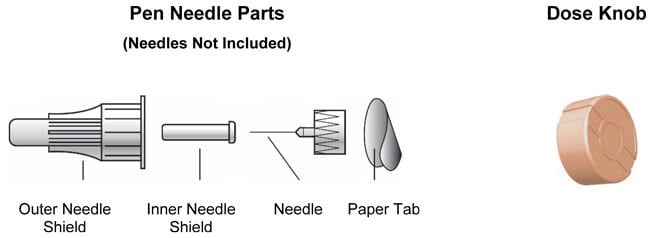
How to recognize your Lyumjev Junior KwikPen
- Pen color: Taupe
- Dose knob: Peach, with raised ridges on end and side
- Label: White with a peach color bar, and peach, light blue and dark blue color band
Supplies needed to give your injection
- Lyumjev Junior KwikPen, 100 units/mL
- KwikPen compatible needle (Becton, Dickinson and Company Pen needles recommended)
- Alcohol swab
- Gauze (optional)
Preparing your Pen
- Wash your hands with soap and water.
- Check the Pen to make sure you are taking the right type of insulin. This is especially important if you use more than 1 type of insulin.
- Do not use your Pen past the expiration date printed on the label or for more than 28 days after you first start using the Pen.
- Always use a new needle for each injection to help prevent infections and blocked needles.
Step 1:
- Pull the Pen cap straight off.
- Do not remove the Pen label.
- Wipe the rubber seal with an alcohol swab.
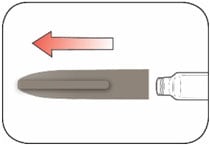
Step 2:
- Check the liquid in the Pen.
- Lyumjev should look clear and colorless. Do not use if it is cloudy, colored, or has particles or clumps in it.
Step 3:
- Select a new needle.
- Pull off the paper tab from the outer needle shield.
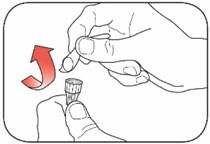
Step 4:
- Push the capped needle straight onto the Pen and twist the needle on until it is tight.
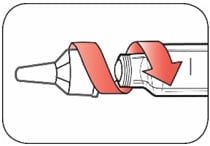
Step 5:
- Pull off the outer needle shield. Do not throw it away.
- Pull off the inner needle shield and throw it away.
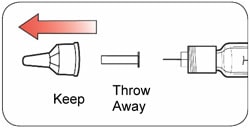
Priming your Pen
Prime before each injection.
- Priming your Pen means removing the air from the needle and cartridge that may collect during normal use and ensures that your Pen is working correctly.
- If you do not prime before each injection, you may get too much or too little insulin.
Step 6:
- To prime your Pen, turn the dose knob to select 2 units.
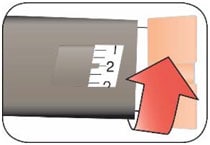
Step 7:
- Hold your Pen with the needle pointing up. Tap the cartridge holder gently to collect air bubbles at the top.
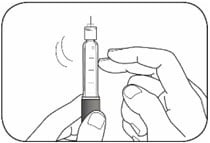
Step 8:
- Continue holding your Pen with the needle pointing up. Push the dose knob in until it stops and “0” is seen in the dose window. Hold the dose knob in and count to 5 slowly.
You should see insulin at the tip of the needle.
- If you do not see insulin, repeat priming steps 6 to 8, but not more than 4 times.
- If you still do not see insulin, change the needle and repeat priming steps 6 to 8.
Small air bubbles are normal and will not affect your dose.
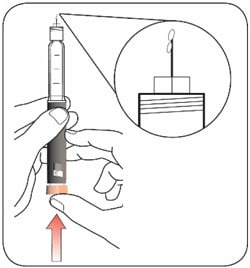
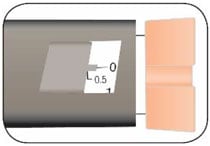
Selecting your dose
- You can give from 0.5 (½) to 30 units in a single injection.
- If your dose is more than 30 units, you will need to give more than 1 injection.
- If you need help with dividing up your dose the right way, ask your healthcare provider.
- Use a new needle for each injection and repeat the priming steps.
- If you usually need more than 30 units, ask your healthcare provider if a different Lyumjev Pen would be better for you.
Step 9:
- Turn the dose knob to select the number of units you need to inject. The dose indicator should line up with your dose.
- The Pen dials 0.5 (½) unit at a time.
- The dose knob clicks as you turn it.
- Do not dial your dose by counting the clicks. You may dial the wrong dose. This may lead to you getting too much insulin or not enough insulin.
- The dose can be corrected by turning the dose knob in either direction until the correct dose lines up with the dose indicator.
- The whole unit numbers are printed on the dial. The example to the right shows 4 units in the dose window.
- The half units are shown as lines between the whole unit numbers. The example to the right shows 10.5 units in the dose window.
- Always check the number in the dose window to make sure you have dialed the correct dose.
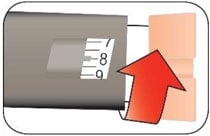
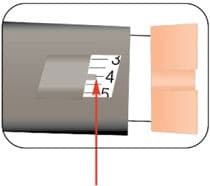
Example: 4 units shown in the dose window
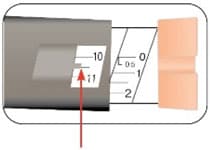
Example: 10.5 (10 ½) units shown in the dose window
- The Pen will not let you dial more than the number of units left in the Pen.
- If you need to inject more than the number of units left in the Pen, you may either:
- inject the amount left in your Pen and then use a new Pen to give the rest of your dose, or
- get a new Pen and inject the full dose.
- It is normal to see a small amount of insulin left in the Pen that you cannot inject.
Giving your injection
- Inject your insulin as your healthcare provider has shown you.
- Change (rotate) your injection sites within the area you choose for each dose to reduce your risk of getting lipodystrophy (pits in skin or thickened skin) and localized cutaneous amyloidosis (skin with lumps) at the injection sites.
- Do not use the exact same spot for each injection.
- Do not inject where the skin has pits, is thickened, or has lumps.
- Do not inject where the skin is tender, bruised, scaly or hard, or into scars or damaged skin.
- Do not try to change your dose while injecting.
Step 10:
- Choose your injection site.
Lyumjev is injected under the skin (subcutaneously) of your stomach area, buttocks, upper legs or upper arms. - Wipe your skin with an alcohol swab, and let your skin dry before you inject your dose.
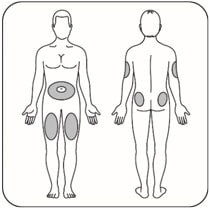
Step 11:
- Insert the needle into your skin.
- Push the dose knob all the way in.
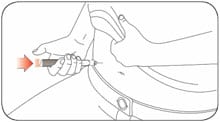
- Continue to hold the dose knob in and slowly count to 5 before removing the needle.
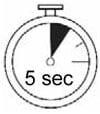
Do not try to inject your insulin by turning the dose knob. You will not receive your insulin by turning the dose knob.
Step 12:
- Pull the needle out of your skin.
- A drop of insulin at the needle tip is normal. It will not affect your dose.
- Check the number in the dose window.
- If you see “0” in the dose window, you have received the full amount you dialed.
- If you do not see “0” in the dose window, you did not receive your full dose. Do not redial. Insert the needle into your skin and finish your injection.
- If you still do not think you received the full amount you dialed for your injection, do not start over or repeat that injection. Monitor your blood glucose as instructed by your healthcare provider.
- If you normally need to give 2 injections for your full dose, be sure to give your second injection.
The plunger only moves a little with each injection, and you may not notice that it moves.
If you see blood after you take the needle out of your skin, press the injection site lightly with a piece of gauze or an alcohol swab. Do not rub the area.
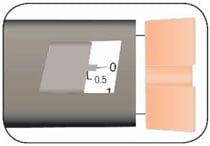
After your injection
Step 13:
- Carefully replace the outer needle shield.
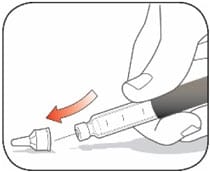
Step 14:
- Unscrew the capped needle and throw it away (see Disposing of pens and needles section).
- Do not store the Pen with the needle attached to prevent leaking, blocking the needle, and air from entering the Pen.
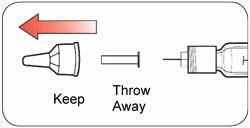
Step 15:
- Replace the Pen cap by lining up the cap clip with the dose indicator and pushing straight on.
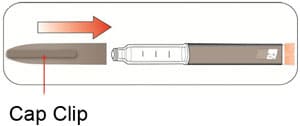
Disposing of Pens and needles
- Put your used needles in a FDA-cleared sharps disposal container right away after use. Do not throw away (dispose of) loose needles in your household trash.
- If you do not have a FDA-cleared sharps disposal container, you may use a household container that is:
- made of a heavy-duty plastic,
- can be closed with a tight-fitting, puncture-resistant lid, without sharps being able to come out,
- upright and stable during use,
- leak-resistant, and
- properly labeled to warn of hazardous waste inside the container.
- When your sharps disposal container is almost full, you will need to follow your community guidelines for the right way to dispose of your sharps disposal container. There may be state or local laws about how you should throw away used needles and syringes. For more information about safe sharps disposal, and for specific information about sharps disposal in the state that you live in, go to the FDA’s website at: http://www.fda.gov/safesharpsdisposal
- Do not dispose of your used sharps disposal container in your household trash unless your community guidelines permit this. Do not recycle your used sharps disposal container.
- The used Pen may be discarded in your household trash after you have removed the needle.
Storing your Pen
Unused Pens
- Store unused Pens in the refrigerator at 36°F to 46°F (2°C to 8°C).
- Do not freeze Lyumjev. Do not use if it has been frozen.
- Unused Pens may be used until the expiration date printed on the label if the Pen has been kept in the refrigerator.
In-use Pen
- Store the Pen you are currently using at room temperature [up to 86°F (30°C)]. Keep away from heat and light.
- Throw away the Lyumjev Junior KwikPen you are using after 28 days, even if it still has insulin left in it.
General information about the safe and effective use of your Pen
- Keep your Pen and needles out of the sight and reach of children.
- Do not use your Pen if any part looks broken or damaged.
- Always carry an extra Pen in case yours is lost or damaged.
Troubleshooting
- If you cannot remove the Pen cap, gently twist the cap back and forth, and then pull the cap straight off.
- If the dose knob is hard to push:
- pushing the dose knob more slowly will make it easier to inject.
- your needle may be blocked. Put on a new needle and prime the Pen.
- you may have dust, food, or liquid inside the Pen. Throw the Pen away and get a new Pen.
If you have any questions or problems with your Lyumjev Junior KwikPen, contact Lilly at 1-800-545-5979 or call your healthcare provider for help. For more information on Lyumjev Junior KwikPen and insulin, go to www.Lyumjev.com.
Instructions for use issued 06/2020.
Lyumjev Tempo Pen (LOOM-jehv)
(insulin lispro-aabc)
injection, for subcutaneous use
3 mL single-patient-use pen
100 units/mL

Read the Instructions for Use before you start taking Lyumjev and each time you get another Lyumjev Tempo Pen. There may be new information. This information does not take the place of talking to your healthcare provider about your medical condition or your treatment.
Do not share your Lyumjev Tempo Pen with other people, even if the needle has been changed. Do not reuse or share needles with other people. You may give other people a serious infection or get a serious infection from them.
Lyumjev Tempo Pen (“Pen”) is a disposable single-patient-use prefilled pen containing 300 units of Lyumjev.
- Your healthcare provider will tell you how many units to give as your dose and how to inject your prescribed dose of insulin.
- You can give yourself more than 1 dose from the Pen.
- Each turn of the dose knob dials 1 unit of insulin. You can give from 1 to 60 units in a single injection.
- If your dose is more than 60 units, you will need to give yourself more than 1 injection. Always check the number in the dose window to make sure you dialed the correct dose.
- The plunger only moves a little with each injection, and you may not notice that it moves. The plunger will only reach the end of the cartridge when you have used all 300 units in the Pen.
- This Lyumjev Tempo Pen contains a component that allows for data connectivity when used with a compatible transmitter.
People who are blind or have vision problems should not use the Pen without help from a person trained to use the Pen.


How to recognize your Lyumjev Tempo Pen
- Pen color: Taupe
- Dose Knob: Blue, with raised ridges around the entire side
- Label: Blue and white
Supplies needed to give your injection
- Lyumjev Tempo Pen, 100 units/mL
- Tempo Pen compatible needle (Becton, Dickinson and Company Pen needles recommended)
- Alcohol swab
- Gauze (optional)
Preparing your Pen
- Wash your hands with soap and water.
- Check the Pen to make sure you are taking the right type of insulin. This is especially important if you use more than 1 type of insulin.
- Do not use your Pen past the expiration date printed on the label or for more than 28 days after you first start using the Pen.
- Always use a new needle for each injection to help prevent infections and blocked needles.
Step 1:
- Pull the Pen cap straight off.
- Do not remove the Pen label.
- Wipe the rubber seal with an alcohol swab.

Step 2:
- Check the liquid in the Pen.
- Lyumjev should look clear and colorless. Do not use if it is cloudy, colored, or has particles or clumps in it.
Step 3:
- Select a new needle.
- Pull off the paper tab from the outer needle shield.

Step 4:
- Push the capped needle straight onto the Pen and twist the needle on until it is tight.

Step 5:
- Pull off the outer needle shield. Do not throw it away.
- Pull off the inner needle shield and throw it away.

Priming your Pen
Prime before each injection.
- Priming your Pen means removing the air from the needle and cartridge that may collect during normal use and ensures that your Pen is working correctly.
- If you do not prime before each injection, you may get too much or too little insulin.
Step 6:
- To prime your Pen, turn the dose knob to select 2 units.
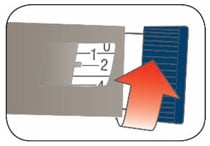
Step 7:
- Hold your Pen with the needle pointing up. Tap the cartridge holder gently to collect air bubbles at the top.

Step 8:
- Continue holding your Pen with the needle pointing up. Push the dose knob in until it stops and “0” is seen in the dose window. Hold the dose knob in and count to 5 slowly.
You should see insulin at the tip of the needle.
- If you do not see insulin, repeat priming steps 6 to 8, but not more than 4 times.
- If you still do not see insulin, change the needle and repeat priming steps 6 to 8.
Small air bubbles are normal and will not affect your dose.
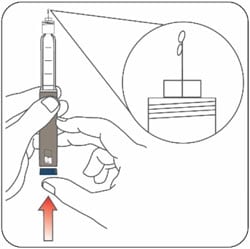
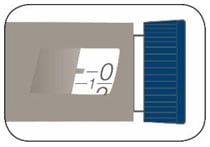
Selecting your dose
- You can give from 1 to 60 units in a single injection.
- If your dose is more than 60 units, you will need to give more than 1 injection.
- If you need help with dividing up your dose the right way, ask your healthcare provider.
- Use a new needle for each injection and repeat the priming steps.
Step 9:
- Turn the dose knob to select the number of units you need to inject. The dose indicator should line up with your dose.
- The Pen dials 1 unit at a time.
- The dose knob clicks as you turn it.
- Do not dial your dose by counting the clicks. You may dial the wrong dose. This may lead to you getting too much insulin or not enough insulin.
- The dose can be corrected by turning the dose knob in either direction until the correct dose lines up with the dose indicator.
- The even numbers are printed on the dial. The example to the right shows 12 units in the dose window.
- The odd numbers, after the number 1, are shown as full lines between the numbers. The example to the right shows 25 units in the dose window.
- Always check the number in the dose window to make sure you have dialed the correct dose.
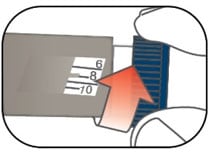
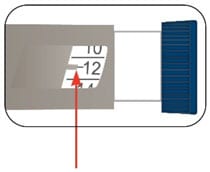
Example: 12 units shown in the dose window
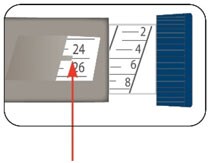
Example: 25 units shown in the dose window
- The Pen will not let you dial more than the number of units left in the Pen.
- If you need to inject more than the number of units left in the Pen, you may either:
- inject the amount left in your Pen and then use a new Pen to give the rest of your dose, or
- get a new Pen and inject the full dose.
- It is normal to see a small amount of insulin left in the Pen that you cannot inject.
Giving your injection
- Inject your insulin as your healthcare provider has shown you.
- Change (rotate) your injection sites within the area you choose for each dose to reduce your risk of getting lipodystrophy (pits in skin or thickened skin) and localized cutaneous amyloidosis (skin with lumps) at the injection sites.
- Do not use the exact same spot for each injection.
- Do not inject where the skin has pits, is thickened, or has lumps.
- Do not inject where the skin is tender, bruised, scaly or hard, or into scars or damaged skin.
- Do not try to change your dose while injecting.
Step 10:
- Choose your injection site.
Lyumjev is injected under the skin (subcutaneously) of your stomach area, buttocks, upper legs or upper arms. - Wipe your skin with an alcohol swab, and let your skin dry before you inject your dose.

Step 11:
- Insert the needle into your skin.
- Push the dose knob all the way in.

- Continue to hold the dose knob in and slowly count to 5 before removing the needle.

Do not try to inject your insulin by turning the dose knob. You will not receive your insulin by turning the dose knob.
Step 12:
- Pull the needle out of your skin.
- A drop of insulin at the needle tip is normal. It will not affect your dose.
- Check the number in the dose window.
- If you see “0” in the dose window, you have received the full amount you dialed.
- If you do not see “0” in the dose window, you did not receive your full dose. Do not redial. Insert the needle into your skin and finish your injection.
- If you still do not think you received the full amount you dialed for your injection, do not start over or repeat that injection. Monitor your blood glucose as instructed by your healthcare provider.
- If you normally need to give 2 injections for your full dose, be sure to give your second injection.
The plunger only moves a little with each injection, and you may not notice that it moves.
If you see blood after you take the needle out of your skin, press the injection site lightly with a piece of gauze or an alcohol swab. Do not rub the area.
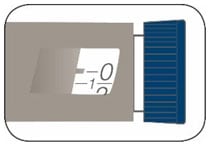
After your injection
Step 13:
- Carefully replace the outer needle shield.

Step 14:
- Unscrew the capped needle and throw it away (see Disposing of pens and needles section).
- Do not store the Pen with the needle attached to prevent leaking, blocking the needle, and air from entering the Pen.
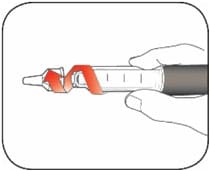
Step 15:
- Replace the Pen cap by lining up the cap clip with the dose indicator and pushing straight on.
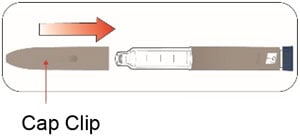
Disposing of Pens and needles
- Put your used needles in a FDA-cleared sharps disposal container right away after use. Do not throw away (dispose of) loose needles in your household trash.
- If you do not have a FDA-cleared sharps disposal container, you may use a household container that is:
- made of a heavy-duty plastic,
- can be closed with a tight-fitting, puncture-resistant lid, without sharps being able to come out,
- upright and stable during use,
- leak-resistant, and
- properly labeled to warn of hazardous waste inside the container.
- When your sharps disposal container is almost full, you will need to follow your community guidelines for the right way to dispose of your sharps disposal container. There may be state or local laws about how you should throw away used needles and syringes. For more information about safe sharps disposal, and for specific information about sharps disposal in the state that you live in, go to the FDA’s website at: http://www.fda.gov/safesharpsdisposal
- Do not dispose of your used sharps disposal container in your household trash unless your community guidelines permit this. Do not recycle your used sharps disposal container.
- The used Pen may be discarded in your household trash after you have removed the needle.
Storing your Pen
Unused Pens
- Store unused Pens in the refrigerator at 36°F to 46°F (2°C to 8°C).
- Do not freeze Lyumjev. Do not use if it has been frozen.
- Unused Pens may be used until the expiration date printed on the label if the Pen has been kept in the refrigerator.
In-use Pen
- Store the Pen you are currently using at room temperature [up to 86°F (30°C)]. Keep away from heat and light.
- Throw away the Lyumjev Tempo Pen you are using after 28 days, even if it still has insulin left in it.
General information about the safe and effective use of your Pen
- Keep your Pen and needles out of the sight and reach of children.
- Do not use your Pen if any part looks broken or damaged.
- Always carry an extra Pen in case yours is lost or damaged.
Troubleshooting
- If you cannot remove the Pen cap, gently twist the cap back and forth, and then pull the cap straight off.
- If the dose knob is hard to push:
- pushing the dose knob more slowly will make it easier to inject.
- your needle may be blocked. Put on a new needle and prime the Pen.
- you may have dust, food, or liquid inside the Pen. Throw the Pen away and get a new Pen.
If you have any questions or problems with your Lyumjev Tempo Pen, contact Lilly at 1-800-545-5979 or call your healthcare provider for help. For more information on Lyumjev Tempo Pen and insulin, go to www.Lyumjev.com.
Instructions for use issued 06/2020.
Lyumjev KwikPen (LOOM-jehv)
(insulin lispro-aabc)
injection, for subcutaneous use
3 mL single-patient-use pen
200 units/mL


Read the Instructions for Use before you start taking Lyumjev and each time you get another Lyumjev KwikPen. There may be new information. This information does not take the place of talking to your healthcare provider about your medical condition or your treatment.
Do not share your Lyumjev KwikPen with other people, even if the needle has been changed. Do not reuse or share needles with other people. You may give other people a serious infection or get a serious infection from them.
Lyumjev KwikPen (“Pen”) is a disposable single-patient-use prefilled pen containing 600 units of Lyumjev.
- Your healthcare provider will tell you how many units to give as your dose and how to inject your prescribed dose of insulin.
- You can give yourself more than 1 dose from the Pen.
- Each turn of the dose knob dials 1 unit of insulin. You can give from 1 to 60 units in a single injection.
- If your dose is more than 60 units, you will need to give yourself more than 1 injection. Always check the number in the dose window to make sure you dialed the correct dose.
- The plunger only moves a little with each injection, and you may not notice that it moves. The plunger will only reach the end of the cartridge when you have used all 600 units in the Pen.
Lyumjev KwikPen is available in two strengths, 100 units/mL and 200 units/mL. Inject Lyumjev 200 units/mL only with your Pen. Do not transfer insulin from your Pen to a syringe. Syringes will not measure 200 units/mL of insulin correctly. A severe overdose can result, causing very low blood sugar which may put your life in danger.
People who are blind or have vision problems should not use the Pen without help from a person trained to use the Pen.
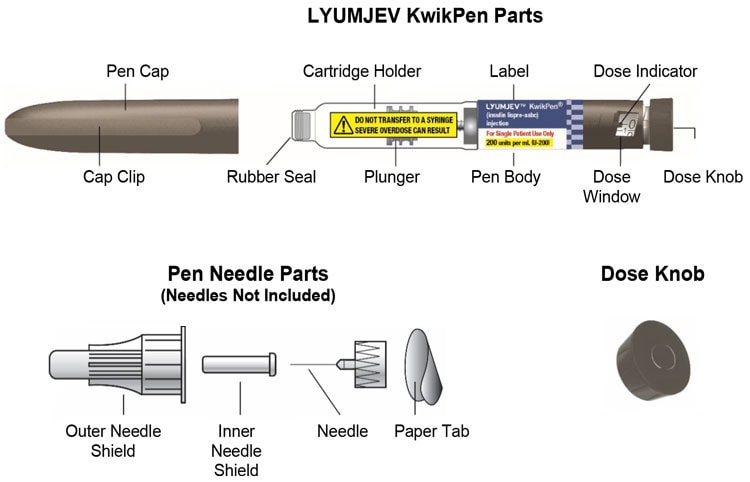
How to recognize your Lyumjev KwikPen
- Pen color: Taupe
- Dose Knob: Taupe, with raised ridges on side
- Label: White with a blue color bar and checkerboard design with “200 units per mL (U-200)” in a yellow stripe. Yellow warning on cartridge holder.
Supplies needed to give your injection
- Lyumjev KwikPen, 200 units/mL
- KwikPen compatible needle (Becton, Dickinson and Company Pen needles recommended)
- Alcohol swab
- Gauze (optional)
Preparing your Pen
- Wash your hands with soap and water.
- Check the Pen to make sure you are taking the right type of insulin. This is especially important if you use more than 1 type of insulin.
- Do not use your Pen past the expiration date printed on the label or for more than 28 days after you first start using the Pen.
- Always use a new needle for each injection to help prevent infections and blocked needles.
Step 1:
- Pull the Pen cap straight off.
- Do not remove the Pen label.
- Wipe the rubber seal with an alcohol swab.
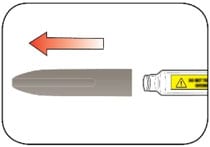

Step 2:
- Check the liquid in the Pen.
- Lyumjev should look clear and colorless. Do not use if it is cloudy, colored, or has particles or clumps in it.
Step 3:
- Select a new needle.
- Pull off the paper tab from the outer needle shield.

Step 4:
- Push the capped needle straight onto the Pen and twist the needle on until it is tight.
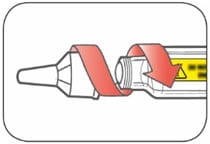
Step 5:
- Pull off the outer needle shield. Do not throw it away.
- Pull off the inner needle shield and throw it away.
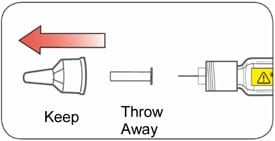
Priming your Pen
Prime before each injection.
- Priming your Pen means removing the air from the needle and cartridge that may collect during normal use and ensures that your Pen is working correctly.
- If you do not prime before each injection, you may get too much or too little insulin.
Step 6:
- To prime your Pen, turn the dose knob to select 2 units.
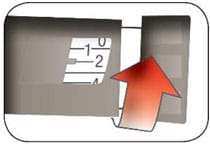
Step 7:
- Hold your Pen with the needle pointing up. Tap the cartridge holder gently to collect air bubbles at the top.
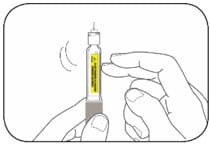
Step 8:
- Continue holding your Pen with the needle pointing up. Push the dose knob in until it stops and “0” is seen in the dose window. Hold the dose knob in and count to 5 slowly.
You should see insulin at the tip of the needle.
- If you do not see insulin, repeat priming steps 6 to 8, but not more than 8 times.
- If you still do not see insulin, change the needle and repeat priming steps 6 to 8.
Small air bubbles are normal and will not affect your dose.
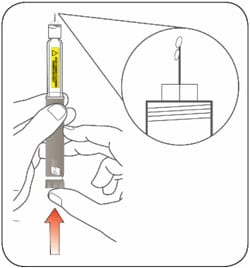
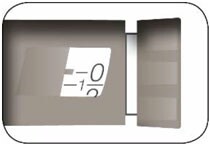
Selecting your dose
This Pen has been designed to deliver the dose that is shown in the dose window. Dial your usual dose as instructed by your healthcare provider.
- You can give from 1 to 60 units in a single injection.
- If your dose is more than 60 units, you will need to give more than 1 injection.
- If you need help with dividing up your dose the right way, ask your healthcare provider.
- Use a new needle for each injection and repeat the priming steps.
Step 9:
- Turn the dose knob to select the number of units you need to inject. The dose indicator should line up with your dose.
- The Pen dials 1 unit at a time.
- The dose knob clicks as you turn it.
- Do not dial your dose by counting the clicks. You may dial the wrong dose. This may lead to you getting too much insulin or not enough insulin.
- The dose can be corrected by turning the dose knob in either direction until the correct dose lines up with the dose indicator.
- The even numbers are printed on the dial. The example to the right shows 12 units in the dose window.
- The odd numbers, after the number 1, are shown as full lines between the numbers. The example to the right shows 25 units in the dose window.
- Always check the number in the dose window to make sure you have dialed the correct dose.
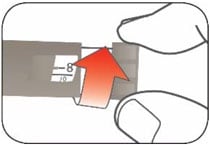
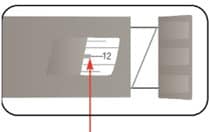
Example: 12 units shown in the dose window
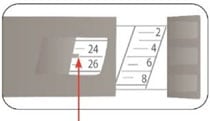
Example: 25 units shown in the dose window
- The Pen will not let you dial more than the number of units left in the Pen.
- If you need to inject more than the number of units left in the Pen, you may either:
- inject the amount left in your Pen and then use a new Pen to give the rest of your dose, or
- get a new Pen and inject the full dose.
- It is normal to see a small amount of insulin left in the Pen that you cannot inject. Do not transfer this to a syringe. Severe overdose can result.
Giving your injection
- Inject your insulin as your healthcare provider has shown you.
- Change (rotate) your injection sites within the area you choose for each dose to reduce your risk of getting lipodystrophy (pits in skin or thickened skin) and localized cutaneous amyloidosis (skin with lumps) at the injection sites.
- Do not use the exact same spot for each injection.
- Do not inject where the skin has pits, is thickened, or has lumps.
- Do not inject where the skin is tender, bruised, scaly or hard, or into scars or damaged skin.
- Do not try to change your dose while injecting.
Step 10:
- Choose your injection site.
Lyumjev is injected under the skin (subcutaneously) of your stomach area, buttocks, upper legs or upper arms. - Wipe your skin with an alcohol swab, and let your skin dry before you inject your dose.

Step 11:
- Insert the needle into your skin.
- Push the dose knob all the way in.

- Continue to hold the dose knob in and slowly count to 5 before removing the needle.

Do not try to inject your insulin by turning the dose knob. You will not receive your insulin by turning the dose knob.
Step 12:
- Pull the needle out of your skin.
- A drop of insulin at the needle tip is normal. It will not affect your dose.
- Check the number in the dose window.
- If you see “0” in the dose window, you have received the full amount you dialed.
- If you do not see “0” in the dose window, you did not receive your full dose. Do not redial. Insert the needle into your skin and finish your injection.
- If you still do not think you received the full amount you dialed for your injection, do not start over or repeat that injection. Monitor your blood glucose as instructed by your healthcare provider.
- If you normally need to give 2 injections for your full dose, be sure to give your second injection.
The plunger only moves a little with each injection, and you may not notice that it moves.
If you see blood after you take the needle out of your skin, press the injection site lightly with a piece of gauze or an alcohol swab. Do not rub the area.
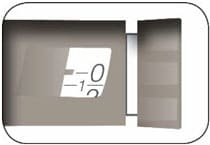
After your injection
Step 13:
- Carefully replace the outer needle shield.
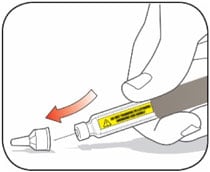
Step 14:
- Unscrew the capped needle and throw it away (see Disposing of pens and needles section).
- Do not store the Pen with the needle attached to prevent leaking, blocking the needle, and air from entering the Pen.
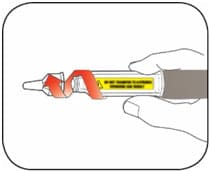
Step 15:
- Replace the Pen cap by lining up the cap clip with the dose indicator and pushing straight on.
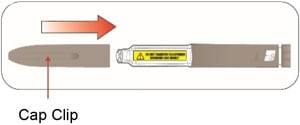
Disposing of Pens and needles
- Put your used needles in a FDA-cleared sharps disposal container right away after use. Do not throw away (dispose of) loose needles in your household trash.
- If you do not have a FDA-cleared sharps disposal container, you may use a household container that is:
- made of a heavy-duty plastic,
- can be closed with a tight-fitting, puncture-resistant lid, without sharps being able to come out,
- upright and stable during use,
- leak-resistant, and
- properly labeled to warn of hazardous waste inside the container.
- When your sharps disposal container is almost full, you will need to follow your community guidelines for the right way to dispose of your sharps disposal container. There may be state or local laws about how you should throw away used needles and syringes. For more information about safe sharps disposal, and for specific information about sharps disposal in the state that you live in, go to the FDA’s website at: http://www.fda.gov/safesharpsdisposal
- Do not dispose of your used sharps disposal container in your household trash unless your community guidelines permit this. Do not recycle your used sharps disposal container.
- The used Pen may be discarded in your household trash after you have removed the needle.
Storing your Pen
Unused Pens
- Store unused Pens in the refrigerator at 36°F to 46°F (2°C to 8°C).
- Do not freeze Lyumjev. Do not use if it has been frozen.
- Unused Pens may be used until the expiration date printed on the label if the Pen has been kept in the refrigerator.
In-use Pen
- Store the Pen you are currently using at room temperature [up to 86°F (30°C)]. Keep away from heat and light.
- Throw away the Lyumjev KwikPen you are using after 28 days, even if it still has insulin left in it.
General information about the safe and effective use of your Pen
- Keep your Pen and needles out of the sight and reach of children.
- Do not use your Pen if any part looks broken or damaged.
- Always carry an extra Pen in case yours is lost or damaged.
Troubleshooting
- If you cannot remove the Pen cap, gently twist the cap back and forth, and then pull the cap straight off.
- If the dose knob is hard to push:
- pushing the dose knob more slowly will make it easier to inject.
- your needle may be blocked. Put on a new needle and prime the Pen.
- you may have dust, food, or liquid inside the Pen. Throw the Pen away and get a new Pen.
Label
PACKAGE LABEL – LYUMJEV U200 KwikPen 5 Count Carton
- Dispense in this sealed carton.
- NDC 0002-8228-27
- LYUMJEVTM KwikPen®
- (insulin lispro-aabc)
- injection
- For Single Patient Use Only
- 200 units per mL (U-200)
- For subcutaneous use
- 2 x 3 mL prefilled pens
- Rx only
- Needles not included
- This device is recommended for use with Becton, Dickinson and Company’s insulin pen needles.
- Lilly
- DO NOT TRANSFER TO A SYRINGE SEVERE OVERDOSE CAN RESULT
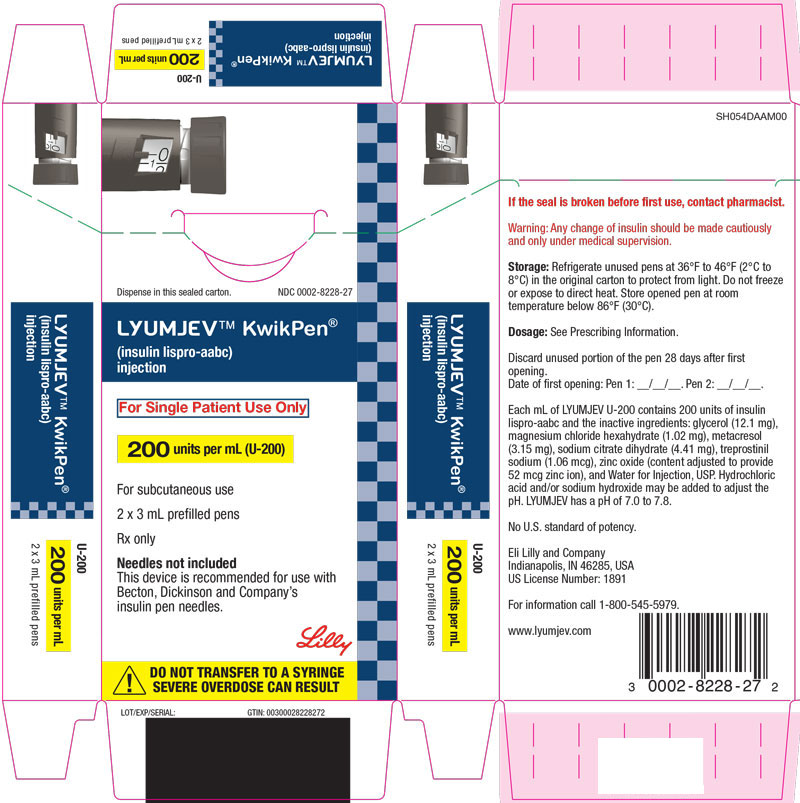
SRC: NLM .
